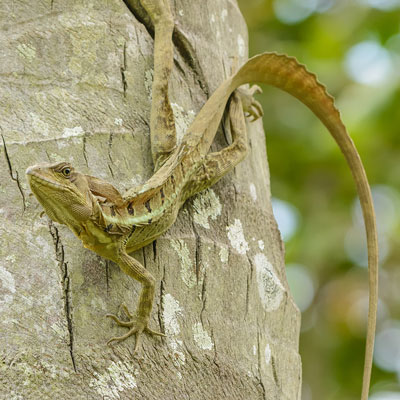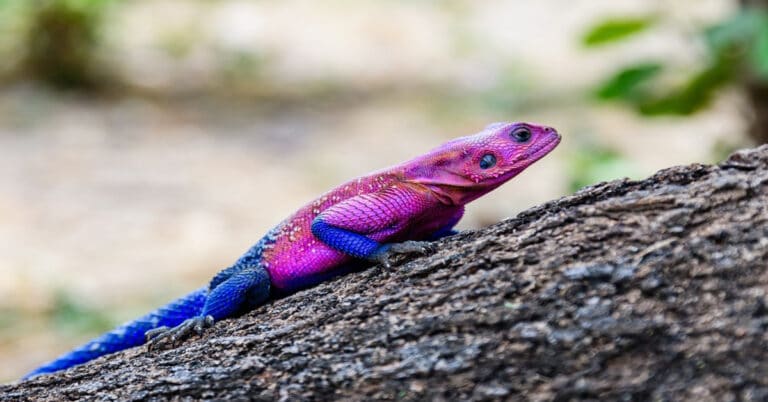Jesus Lizard
Scientific Classification
| Kingdom: | Animalia |
| Phylum: | Chordata |
| Subphylum: | Vertebrata |
| Class: | Reptilia |
| Order: | Squamata |
| Suborder: | Iguania |
| Family: | Corytophanidae |
| Genus: | Basiliscus Laurenti |
The Basilisk lizard genus is commonly called Jesus Lizard, renowned for running across water. The Basiliscus genus, generally called basilisks belongs to the genus of the big Corytophanid lizards; they are prevalent in the provinces of South and North America, Central America, and Southern regions of Mexico. In general, it is known as the Jesus Christ Lizard or just Jesus Lizard because of its ability to run across water bodies for an appreciable distance without sinking.
At times the basilisk lizards run as biped (two-footed animals). Their peculiar ability to “run” over water has earned them the name, “The Jesus Christ Lizard”. This has reference to the passage in the Bible, Mathew 14: 22-34. The basilisks can run over water at about 1.5 meters (4.9 feet) per second for about 4.5 meters (14.8 feet), prior to sinking on their four legs and then swimming. Between their toes, they have flaps creating a pocket of air and a larger surface area. While “water-walking “ they are able to keep going on fours, in order to increase the distance they travel on the surface by approximately 1.3 meters (4.3 feet).

Anatomy
The average basilisks measuring 70-75 mm (2.8 – 3.0 inches) and weighing around 80 grams (3.2 Oz), have an iris with a yellow hue and sport bluish spots on them. They grow continuously and fast when they are young. This Jesus lizard will grow one foot long; normally they do not weigh more than 600 grams during their lifetime of 8 years. They seem like the Edaphosaurus and Dimetrodon on account of the crest-like sails, which are toughened at the three distinctive positions (tail, back and head). They shed their skin in pieces.
Habitat
They occur in plenty in Ecuador to the southern regions of Mexico and Venezuela, in the tropical rain forests of South and Central America. Lately, someone introduced them into Florida, where they have adjusted to the cold winter months by digging under the foliage litter to keep themselves warm. Reports of basilisks sighted in Fort Pierce in the north, on the eastern coast of the state, have appeared, where little groups have crawled towards the Northern Fork of Saint Lucie River.
As a Pet
While they are captives, they have a tendency to behave playful and are not good pets for those owners who desire to handle them often.
Housing & Maintenance

If you just meet the minimal needs of basilisks, they are good captives. Keep them in regular glass terrariums having locks on the screen covers. The size of the enclosure depends on the number of members you have in it. You will see that a combination of one male lizard and three females in a 55 gallon terrarium will do well. As stated above, remember to house a single male along with 2 – 3 females.
In order to imitate their natural home, place strong and big branches for climbing to suit their arboreal behavior.
As they hail from the tropics of America, they require a temperature of 70 to 80 F.
Every species has a different humidity requirement in the terrarium that the owner provides. Misting the terrarium many times a day helps to maintain the relative humidity to 60 – 70%.
Diet
The Jesus lizard takes pleasure in consuming different kinds of insects and enjoy wax worms, mealworms, crickets, Zoophobia, grasshoppers, spiders, and at the times, pinkie mice. Dust their food every week with a fine powdered supplement of vitamin and supplement of calcium along with vitamin D3 one day in the week. You may also provide feeder crickets a diet rich in vitamin. One day a week, gut load your insects. Weekly once or even at lesser frequencies, offer pinky mice and dust them with a supplement.
Breeding
There are many factors that determine successful breeding:
Manipulate the humidity
Temperature
Breed the health of specimens
Photoperiod
Incubate the eggs with care
Diseases & Disorders
Many diseases that affect reptiles in captivity can affect captive basilisks also. Certain specimen exhibit roughened snout tips are. This happens when they rub against the barrier of the tank. It is possible to treat this with ease, but acute cases of rostral sores lead to difficulty arising from serious infection, and complications that can even lead to death.

Having discovered a fondness for insects while pursuing her degree in Biology, Randi Jones was quite bugged to know that people usually dismissed these little creatures as “creepy-crawlies”.







